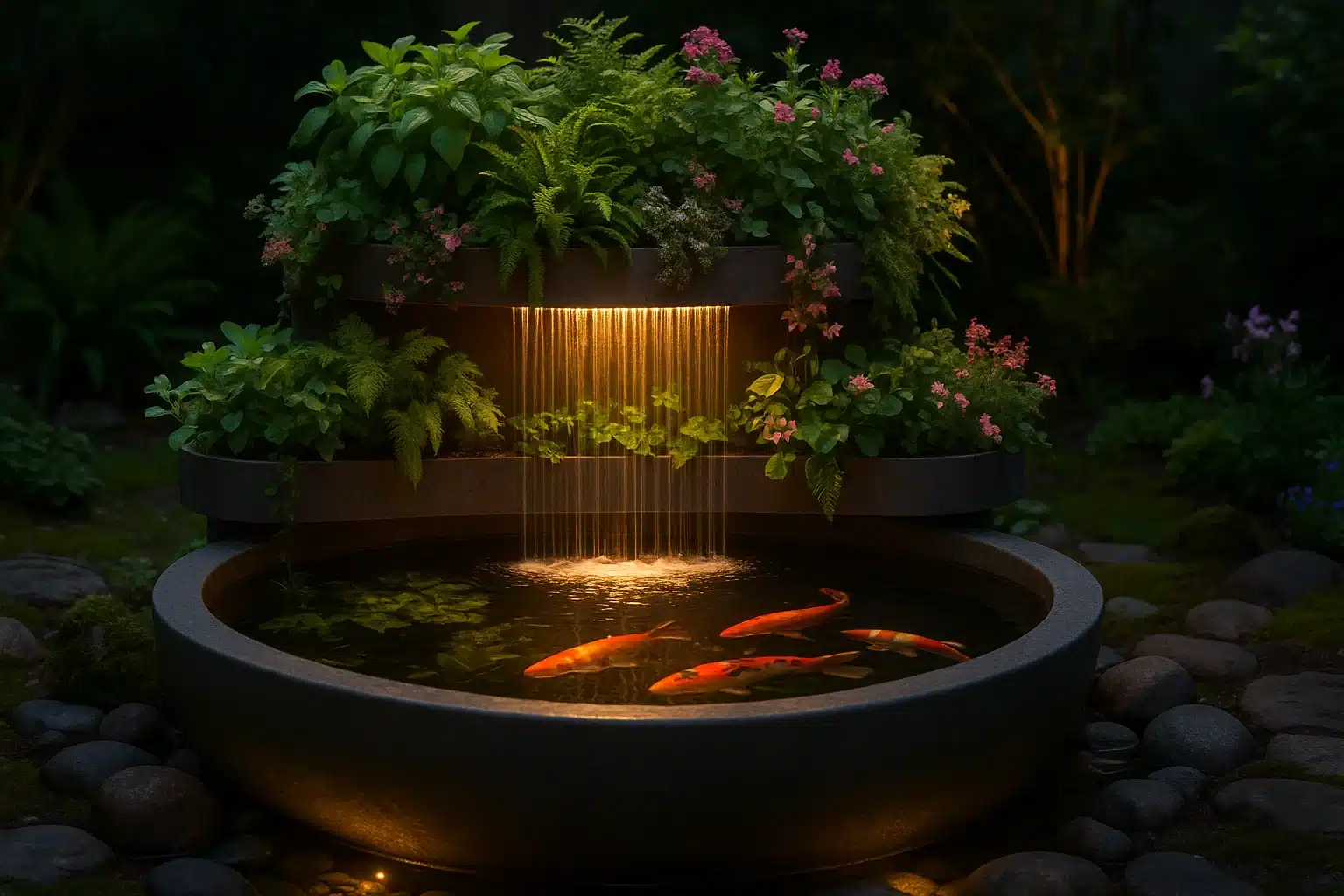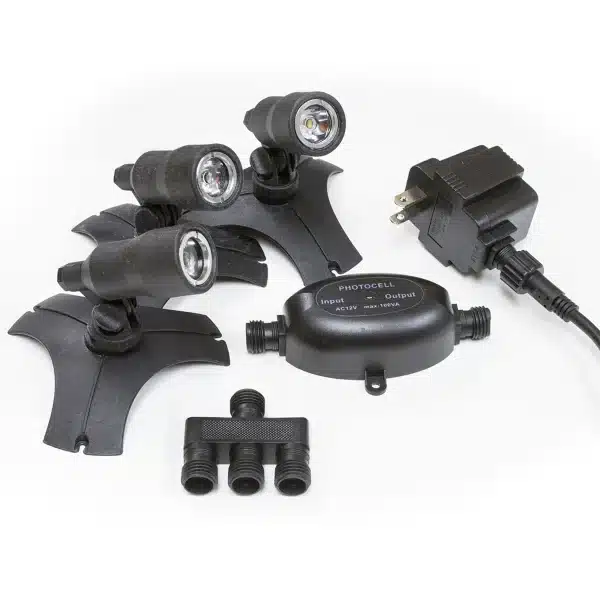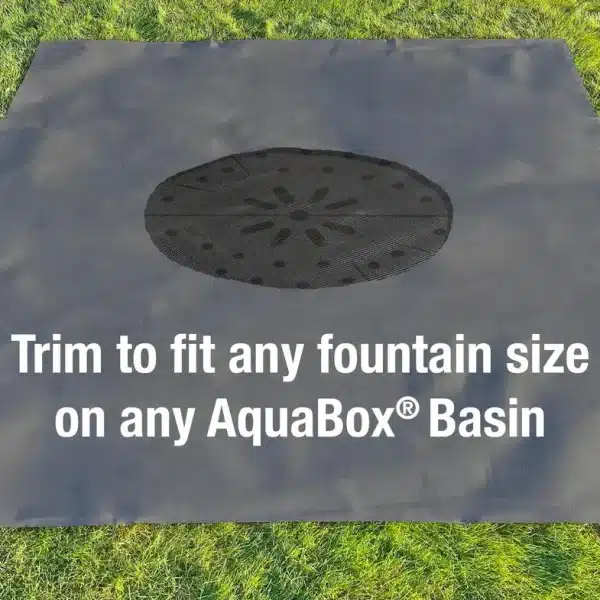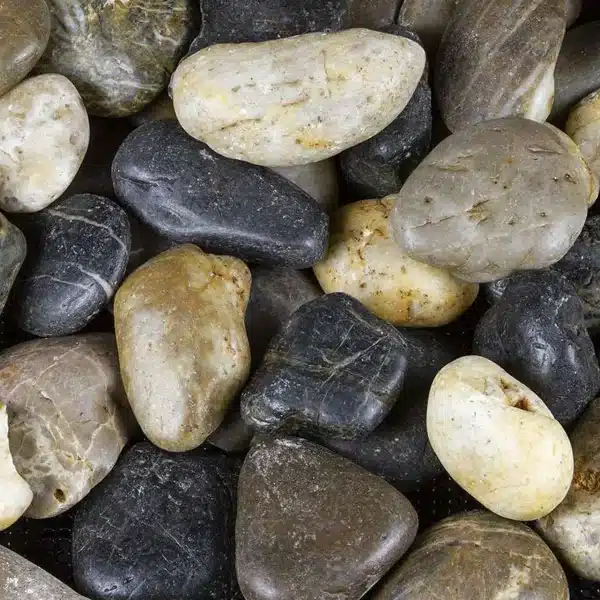Introduction: The Harmony of Water, Fish, and Plants
Few things bring as much peace and beauty to a home or garden as a fountain. The sound of flowing water calms the mind, the sight of rippling movement refreshes the spirit, and when combined with fish and plants, these water features transform into thriving ecosystems. This is where aquaponics fountains come in, merging decorative fountains with sustainable gardening and aquaculture.
An aquaponics fountain is more than just a water feature; it’s a miniaturized ecosystem where fish and plants live symbiotically. Fish provide nutrients through their waste, and plants filter the water naturally, creating a balanced, low-maintenance system. This guide will take you deep into the world of DIY aquaponics fountains — from design ideas to construction tips, so you can enjoy the benefits of a stunning, living garden fountain indoors or outdoors.
What is an Aquaponics Fountain?
An aquaponics fountain is a hybrid between a traditional water fountain and an aquaponics system. Instead of just circulating water for aesthetic effect, the fountain supports both fish and plants in a closed-loop cycle:
- Fish live in the water basin or pond.
- Fish waste enriches the water with nitrogen compounds.
- Plants, grown in or above the fountain, absorb the nutrients and purify the water.
- A pump circulates clean water back into the fountain feature.
This results in a self-sustaining system that is both ornamental and functional. Unlike regular outdoor fountains or indoor water fountains, aquaponics fountains contribute to food production and ecological balance.
Why Choose DIY Aquaponics Fountains?
1. Sustainability and Eco-Friendliness
Traditional water fountains recycle water but don’t actively improve it. By integrating fish and plants, you create a natural filtration system that conserves water and reduces chemical use.
2. Aesthetic Beauty with Purpose
Whether you prefer tabletop fountains, floor fountains, or large outdoor water fountains, aquaponics brings living vibrancy. Floating greenery, colorful fish, and flowing water combine into a spectacular centerpiece.
3. Food Production
Many aquaponics enthusiasts grow herbs like basil, mint, or even leafy greens above their garden fountains, turning decoration into productivity.
4. Stress Relief and Mental Health
Studies show that water features reduce stress, improve focus, and enhance mood. Add in fish-watching and plant care, and you’ve got a multi-sensory relaxation tool right at home.
Choosing the Right Fountain Style for Aquaponics
When deciding on your DIY aquaponics fountain, the type of fountain you choose will shape the system’s design and functionality. Let’s explore some fountain styles that work well with aquaponics.
1. Outdoor Fountains
Outdoor garden fountains provide plenty of space for larger fish like koi, goldfish, or tilapia. These fountains can handle larger water basins, allowing for diverse plant setups like water lilies, lotus, or vertical grow towers.
2. Indoor Water Fountains
Smaller indoor fountains or tabletop fountains are perfect for those who want aquaponics in a limited space. Betta fish, guppies, or small tetras can thrive here, paired with herbs or decorative plants like pothos.
3. Wall Fountains
Indoor wall fountains and outdoor wall-mounted designs can incorporate aquaponic grow beds above or beside the water stream. This setup maximizes vertical space while creating a striking water feature.
4. Rain Curtain Fountain
A rain curtain fountain, where water flows in thin streams like rainfall — can be adapted into an aquaponics setup by placing fish in the basin and plants in vertical hydroponic trays. This creates a stunning modern rain curtain water feature with living organisms.
5. Floor Fountains
Freestanding floor fountains offer flexibility for indoor aquaponics systems. You can design them with hidden grow beds at the base or tiered levels of greenery cascading down.
Key Components of a DIY Aquaponics Fountain
To build your own aquaponics fountain, you’ll need several core components:
- Water Basin or Reservoir – The main body of the fountain, where fish live.
- Pump & Tubing – To circulate water between fish and plants.
- Growing Medium – Gravel, clay pebbles, or soil alternatives for plant roots.
- Fish – Species chosen based on system size (goldfish, tilapia, koi, bettas).
- Plants – Herbs, leafy greens, flowers, or decorative plants.
- Fountain Style – Chosen aesthetic: garden fountain, indoor tabletop fountain, wall fountain, etc.
Step-by-Step: Building Your DIY Aquaponics Fountain
Step 1: Select the Location
Decide if your aquaponics fountain will be an outdoor fountain or an indoor water fountain. Outdoor locations allow for larger systems, but indoor setups are more manageable year-round.
Step 2: Choose Your Fountain Design
Pick between floor fountains, wall fountains, rain curtain fountains, or tabletop fountains depending on your space and goals.
Step 3: Prepare the Water Basin
Install a reservoir or use the built-in basin of your fountain. Ensure it’s waterproof and large enough to house fish comfortably.
Step 4: Add a Pump and Circulation System
The pump should be strong enough to move water from the fish tank to the grow bed or plant area, then back down through the fountain.
Step 5: Install Planting Beds
Above or beside the fountain, set up containers or trays filled with a growing medium. This is where your plants will filter the water.
Step 6: Introduce Fish and Plants
Cycle the system with water first, then gradually add fish and plants. Hardy fish like goldfish are ideal for beginners. Start with herbs like basil, parsley, or mint.
Step 7: Maintain Balance
Monitor water quality, fish health, and plant growth. A well-balanced system will thrive with minimal maintenance.
Best Fish for Aquaponics Fountains
Not all fish are equally suited for aquaponics. Consider these options:
- Goldfish – Hardy and colorful; perfect for indoor fountains or tabletop fountains.
- Tilapia – Great for larger outdoor water fountains; fast-growing and edible.
- Koi – Elegant and popular in garden fountains; require more space.
- Betta Fish – Perfect for small indoor water features.
- Guppies or Tetras – Easy to care for in indoor water fountains.
Best Plants for Aquaponics Fountains
Some plants thrive better in aquaponics than others. Good choices include:
- Herbs: Basil, mint, parsley, chives.
- Leafy Greens: Lettuce, spinach, kale.
- Decorative Plants: Pothos, peace lilies, ferns.
- Flowering Plants: Marigolds, water hyacinths, orchids (with hydroponic media).
Maintenance Tips for Longevity
- Check Water Quality Weekly – Balance pH, ammonia, and nitrates.
- Feed Fish Moderately – Overfeeding causes waste buildup.
- Trim Plants Regularly – Prevent overgrowth that blocks water circulation.
- Clean the Pump – Avoid clogs in tubing or filters.
- Top Off Water – Evaporation occurs more quickly in outdoor fountains.
Creative Design Ideas
- Combine a rain curtain water feature with cascading plants for a modern look.
- Create a tiered garden fountain where each level houses a different type of plant.
- Use wall fountains indoors with herbs for a vertical kitchen garden.
- Install LED lights in indoor fountains to highlight fish at night.
- Pair tabletop fountains with succulents or bonsai trees for a Zen effect.
Benefits Beyond Aesthetics
Aquaponics fountains do more than beautify your space. They:
- Reduce water consumption compared to traditional gardening.
- Offer small-scale food production in urban settings.
- Support biodiversity by combining fish, plants, and microbes.
- Enhance relaxation and mindfulness in your environment.
Conclusion
DIY aquaponics fountains are a perfect fusion of water features and living ecosystems. From small indoor fountains to grand outdoor water fountains, you can create a sustainable, beautiful, and functional centerpiece that benefits both you and the environment. Whether you dream of a rain curtain fountain in your living room, a garden fountain buzzing with greenery, or a compact tabletop fountain with herbs, aquaponics lets you merge beauty with purpose.







